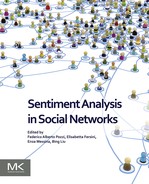Table of Contents
Chapter 1: Challenges of Sentiment Analysis in Social Networks: An Overview
2 Sentiment Analysis in Social Networks: A New Research Approach
3 Sentiment Analysis Characteristics
2 Definitions and History of Online Social Networks
3 Are Online Social Networks All the Same? Features and Metrics
5 From Sociology Principles to Social Networks Analytics
6 How Can Social Network Analytics Improve Sentiment Analysis on Online Social Networks?
7 Conclusion and Future Directions
Chapter 3: Semantic Aspects in Sentiment Analysis
2 Semantic Resources for Sentiment Analysis
3 Using Semantics in Sentiment Analysis
Chapter 4: Linked Data Models for Sentiment and Emotion Analysis in Social Networks
2 Marl: A Vocabulary for Sentiment Annotation
3 Onyx: A Vocabulary for Emotion Annotation
4 Linked Data Corpus Creation for Sentiment Analysis
5 Linked Data Lexicon Creation for Sentiment Analysis
6 Sentiment and Emotion Analysis Services
7 Case Study: Generation of a Domain-Specific Sentiment Lexicon
Chapter 5: Sentic Computing for Social Network Analysis
5 Future Trends and Directions
Chapter 6: Sentiment Analysis in Social Networks: A Machine Learning Perspective
2 Polarity Classification in Online Social Networks: The Key Elements
3 Polarity Classification: Natural Language and Relationships
Chapter 7: Irony, Sarcasm, and Sentiment Analysis
3 Figurative Language and Sentiment Analysis
4 Future Trends and Directions
Chapter 8: Suggestion Mining From Opinionated Text
3 Task Definition and Typology of Suggestions
5 Approaches for Suggestion Detection
7 Future Trends and Directions
Chapter 9: Opinion Spam Detection in Social Networks
3 Review Spammer Detection Leveraging Reviewing Burstiness
4 Detecting Campaign Promoters on Twitter
5 Spotting Spammers Using Collective Positive-Unlabeled Learning
Chapter 10: Opinion Leader Detection
Chapter 11: Opinion Summarization and Visualization
Chapter 12: Sentiment Analysis With SpagoBI
2 Social Network Analysis With SpagoBI
2 Definition of Sentiment and Emotion Mining
4 A Silver Standard Corpus for Emotion Classification in Tweets
2 The Current Philosophy Around Sentiment Analysis
3 KRC Research’s Digital Content and Sentiment Philosophy
4 KRC Research’s Sentiment and Analytics Approach
3 Multidimensional Opinion Metrics
